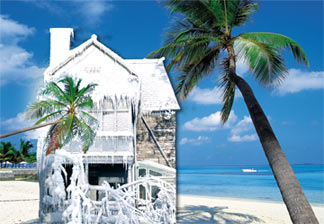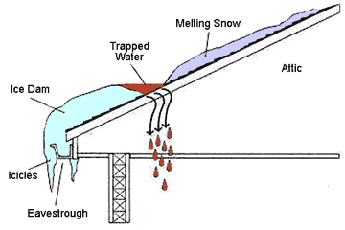
It's that time of year again. The snow that is pretty for some is scary for others. You have experienced, read, or heard about ice damming. You are familiar with the damage the phenomena can cause. Perhaps your Association has spent several hundred thousand or even over a million dollars on roofing improvements and/or replacements within the last few years. Why do we have leaks from ice damming? Wasn't the roof replacement performed correctly or designed correctly? The answer is simple, with a properly designed and installed roof system, the possibility of damage resulting from ice damming should be significantly reduced.
The four (4) main factors that cause ice dams are:
- Snow / ice buildup on the roof.
- Continuously warm/cold temperatures.
- An under ventilated and poorly insulated attic (heat in attic).
- Deficient roof installation (lack of ice and water shield, drip edge, insulation baffles. etc.)
When does it occur?
A typical ice-damming event occurs when the heat escapes from the living quarters into the attic and eventually warms the roof deck. The combination of the sun and the interior heat combine to accelerate and exacerbate this process. The melting water runs down the roof deck until it hits the area over the eaves and the gutter. This area remains cold because it is not over a heated space and thus the water begins to freeze and the ice dam forms. As the ice dam builds, it begins to trap more snowmelt, extending the height of the dam. The melting water begins to pool and backs up under the shingles. Severe problems begin when no ice and water shield is present and no drip edge is located behind the gutters.

Many times the problem is partially attributed to the attic insulation being lodged tight up against the underside of the roof at the soffits, thus prohibiting the proper ventilation of the soffit vents. The lack of soffit baffles, to hold back the insulation and create an air space for the ventilation, greatly diminishes the performance of a balanced roof ventilation system. New roof installations and replacement projects should provide balanced natural draft roof ventilation. As stated previously, ice dams form when a roof has warm upper surfaces and cold lower surfaces. The solution is to equalize temperatures over the entire roof. Heating an entire roof is impractical (and extremely costly), so the most effective solution is to create a cold roof. The most efficient system uses an equal balance of ingress and egress ventilation. Cold outside air is drawn into the soffit vents where it continues up the underside of the roof decking and out through the ridge vent, dome (button) vents, or gable vents. This even distribution of airflow minimizes variations in roof temperatures from the peak to the eaves and reduces the possible occurrence of ice damming.
How to Prevent
Another line of defense against infiltrating water is the proper installation of an ice and water shield or an equivalent waterproofing membrane and drip edge installation. The ice and water shield must project a minimum twenty-four (24) inches past the interior face of the exterior wall to meet the building code requirements. The issue of proper ventilation and ice shields at the eave is not an option that the association may choose to comply with. They are code requirements. The issue of adequate ventilation is also a requirement of all shingle manufacturers to comply with warranty issues. If the association opts not to install adequate ventilation with a new roof, they are in effect voiding the warranty of the new shingles (typically a 20 to 30 year warranty).
Additional Steps
An Association or developer can take additional steps at the time of construction or roof replacement that will greatly reduce possibilities of leaks resulting from ice damming. These include installing drip edges at the eaves and rakes and installing a continuous run of ice shield along the step walls, low slope roof areas, and other vulnerable locations. Drip edge installation, installed correctly, can also act to protect the eaves from water infiltration at the eaves. Additional ice shields prevent water from penetrating back into the building envelope even when ice damming does exist.
A roof replacement project should include or should have included these very important aspects to ensure that a quality work product is/was achieved and ice damming potential is minimized. Attention to detail in the installation of all flashings and roofing components also has a significant effect on the performance of the roof system under these extreme conditions.
Completely eliminating any possibility of damage resulting from ice damming is difficult while remaining within standard building costs and practices, however, even under severe conditions, if your roof has been engineered and installed with care, detail and in accordance with the building codes, the chance of damage should be greatly reduced.
For existing roof systems, prevention is also possible. Several measures can be taken to reduce the chance of ice damming. Seal all attic penetrations, for example, around bathroom exhaust fans, plumbing vents, electrical wiring and outlets, with caulking or weather stripping. This helps reduce the heat loss into the attic space. Vent all exhaust fans (bathroom, etc.) outside through the roof. Install an appropriate amount of insulation in the attic. As stated earlier, upgrade to adequate and effective ventilation. Cold air should completely engulf the underside of the roof above the insulation. If there are hot spots, these are the areas that need to be addressed. This ventilation includes not only soffit and roof vents but pre-formed baffles to ensure attic insulation does not block ventilation paths.
 Print
Print Email
Email







